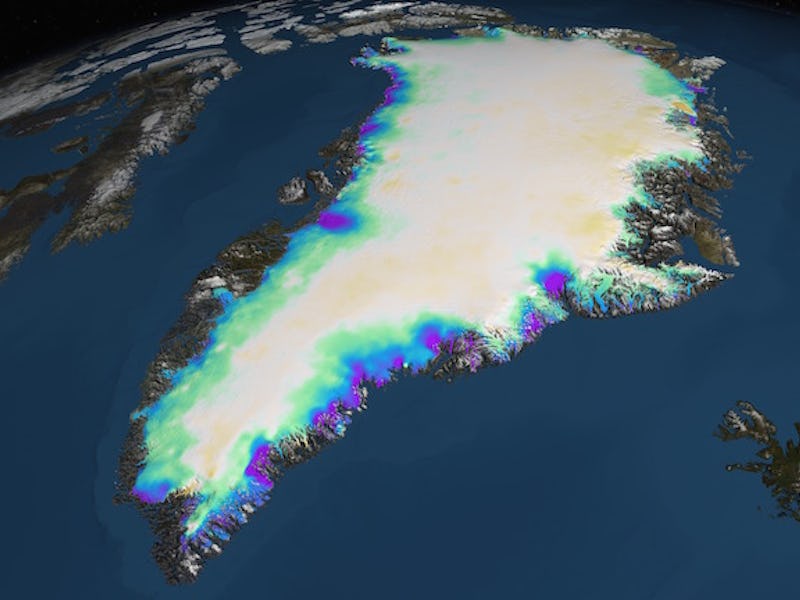Greenland Ice Sheet Researcher Warns: "We Should Prepare for What Is Coming"
A sheet of ice three times the size of Texas is melting at a rapidly accelerating rate.

The first episode of the Netflix documentary series Our Planet features a violin-filled requiem for an iceberg the size of a skyscraper. As it breaks from the Greenland Ice Sheet and drives a colossal tidal wave, narrator David Attenborough explains that glaciers have always released ice into the ocean. What’s different now is that it’s happening more often — and according to a study released Monday in PNAS, it’s occurring at an increasingly rapid rate.
"Over that time period, the mass loss increased sixfold."
Watching a glacier crack with a rumble into the sea is an impressive sight, but to truly understand what’s going on with the Greenland Ice Sheet — a mass of glacial land ice three times the size of Texas — you have to look at its evolution through a historical lens. It’s important, co-author Eric Rignot, Ph.D., a professor at the University of California, Irvine, tells Inverse, to place the recent mass loss into a longer-term context.
Previous research demonstrated that, in 2012, the annual ice loss was already nearly four times the rate it was in 2003. What Rignot and his team found in the new study was alarming: The Greenland Ice Sheet has undergone rapid and irreversible change, and they can pinpoint exactly when the climate of the planet took a terrible turn.
“Going from a 20-year-long record to a 40-year-long record shows us a transition from a climate dominated by natural variability to a climate dominated by climate warming from human emissions of greenhouse gases,” Rignot says. “Over that time period, the mass loss increased sixfold.”
The glacier fall from ]Our Planet'.
To come to this conclusion, they evaluated 46 years worth of data documenting the ice velocity, thickness, and surface elevation of 260 glacial drainage basins. They plugged this data into advanced atmospheric climate models that allowed them to estimate rates of ice accumulation, sublimation, melting at the glacier surface, and the velocity and thickness of ice discharge into the ocean.
The data show that in the ‘70s, the Greenland Ice Sheet gained an average of 47 gigatonnes of ice per year. But by the 1980s, it was losing an average of 50 gigatonnes of ice annually. Rignot explains that this is the time when “the climate of the planet drifted off its natural variability to become dominated by warming from human activity.”
Losing ice is now the new normal. Since the ‘80s, the rate of ice loss has increased sixfold. From 2010 to 2018, the average loss was 290 gigatonnes of ice per year.
Tidewater glacier in Southeast Greenland in the summer of 2018.
This is a matter to take extremely seriously. If all of the Greenland Ice Sheet melted, the sea level would rise about 20 feet. This study estimates that since 1972, Greenland ice loss has raised the sea level by 13.7 millimeters, and half of that rise has happened just in the last eight years.
"In the meantime, we should prepare for what is coming."
They also predict that the mass changes in the northern part of Greenland will have the greatest influence on sea level rise because of its large reserve of ice above sea level and “the potential for manyfold increase in ice discharge.” Rising sea levels expose coastlines to greater risks of flooding, erosion, and hazard from storms. Higher sea levels are already pushing storm surges farther inland than they once did — an endangerment to human life.
Rignot anticipates that these losses will continue to increase every year and that sea level rise rates will progress faster “until we take major actions to curb our carbon emissions and get this climate under control.” At that point, he says, if we’re to really to stabilize this part of the world, we’ll have to also bring it back to a colder state.
“In the meantime,” the Earth system expert advises, “we should prepare for what is coming.”
Abstract:
We reconstruct the mass balance of the Greenland Ice Sheet using a comprehensive survey of thickness, surface elevation, velocity, and surface mass balance (SMB) of 260 glaciers from 1972 to 2018. We calculate mass discharge, D, into the ocean directly for 107 glaciers (85% of D) and indirectly for 110 glaciers (15%) using velocity-scaled reference fluxes. The decadal mass balance switched from a mass gain of +47 ± 21 Gt/y in 1972–1980 to a loss of 51 ± 17 Gt/y in 1980–1990. The mass loss increased from 41 ± 17 Gt/y in 1990–2000, to 187 ± 17 Gt/y in 2000–2010, to 286 ± 20 Gt/y in 2010–2018, or sixfold since the 1980s, or 80 ± 6 Gt/y per decade, on average. The acceleration in mass loss switched from positive in 2000–2010 to negative in 2010–2018 due to a series of cold summers, which illustrates the difficulty of extrapolating short records into longer-term trends. Cumulated since 1972, the largest contributions to global sea level rise are from northwest (4.4 ± 0.2 mm), southeast (3.0 ± 0.3 mm), and central west (2.0 ± 0.2 mm) Greenland, with a total 13.7 ± 1.1 mm for the ice sheet. The mass loss is controlled at 66 ± 8% by glacier dynamics (9.1 mm) and 34 ± 8% by SMB (4.6 mm). Even in years of high SMB, enhanced glacier discharge has remained sufficiently high above equilibrium to maintain an annual mass loss every year since 1998.